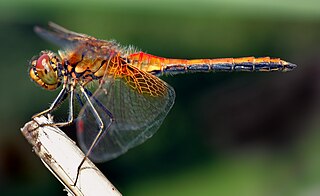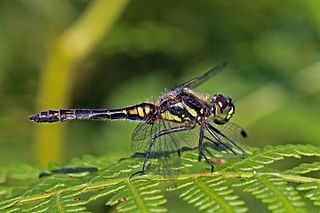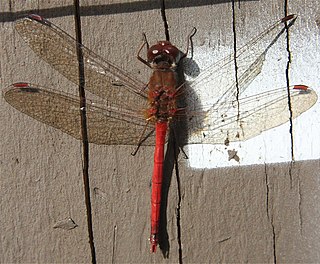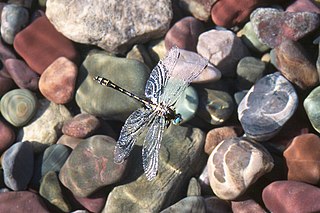
Odonata is an order of flying insects that includes the dragonflies and damselflies. Like most other flying insects, they evolved in the early Mesozoic era. Their prototypes, the giant dragonflies of the Carboniferous, 325 MYA, are no longer placed in the Odonata but included in the Protodonata or Meganisoptera.

A dragonfly is a flying insect belonging to the order Odonata, infraorder Anisoptera. About 3,000 extant species of true dragonfly are known. Most are tropical, with fewer species in temperate regions. Loss of wetland habitat threatens dragonfly populations around the world. Adult dragonflies are characterized by a pair of large, multifaceted compound eyes, two pairs of strong, transparent wings, sometimes with coloured patches, and an elongated body. Many dragonflies have brilliant iridescent or metallic colours produced by structural colouration, making them conspicuous in flight. An adult dragonfly's compound eyes have nearly 24,000 ommatidia each.

Damselflies are flying insects of the suborder Zygoptera in the order Odonata. They are similar to dragonflies, which constitute the other odonatan suborder, Anisoptera, but are smaller and have slimmer bodies. Most species fold the wings along the body when at rest, unlike dragonflies which hold the wings flat and away from the body. An ancient group, damselflies have existed since at least the Lower Permian, and are found on every continent except Antarctica.

The common whitetail or long-tailed skimmer is a common dragonfly across much of North America, with a striking and unusual appearance. The male's chunky white body, combined with the brownish-black bands on its otherwise translucent wings, give it a checkered look. Females have a brown body and a different pattern of wing spots, closely resembling that of female Libellula pulchella, the twelve-spotted skimmer. Whitetail females can be distinguished by their smaller size, shorter bodies, and white zigzag abdominal stripes; the abdominal stripes of L. puchella are straight and yellow.

The flame skimmer or firecracker skimmer is a common dragonfly of the family Libellulidae, native to western North America.

Sympetrum danae, the black darter or black meadowhawk is a dragonfly found in northern Europe, Asia, and North America. At about 30 mm (1.2 in) long, it is Britain's smallest resident dragonfly. It is a very active late summer insect typical of heathland and moorland bog pools.

The blue dasher is a dragonfly of the skimmer family. It is the only species in the genus Pachydiplax. It is very common and widely distributed through North America and into the Bahamas.

The white-faced darter or small whiteface is a dragonfly belonging to the genus Leucorrhinia in the family Libellulidae, characterised by red and black markings and a distinctive white patch on the head. It is found in wetlands and peat bogs from northern Europe eastwards to Siberia, and the adults are active from around April till September, which is known as the "flight period". It breeds in acidic bodies of water, laying its eggs in clumps of sphagnum moss that provide a safe habitat for larval development. The larvae are particularly vulnerable to predation by fish, and so are usually found in lakes where fish are not present. L. dubia is listed as a species of least concern (LC) by the IUCN Red List, however, it is potentially threatened by habitat destruction, pollution, and climate change.

Sympetrum vicinum, the yellow-legged meadowhawk or autumn meadowhawk, is a member of the Libellulidae family and grows to 26–35 mm long.

The tule bluet is a species of damselfly in the family Coenagrionidae found in North America, from northern Mexico to southern Canada.

The band-winged meadowhawk is a dragonfly of the genus Sympetrum belonging to the family Libellulidae.

The marsh bluet is a damselfly species in the family Coenagrionidae.

The dot-tailed whiteface is a species of dragonfly in the family Libellulidae. It is also one of the most common and widespread in the genus Leucorrhinia.

The shadow darner is a species of dragonfly in the family Aeshnidae. It is found in almost all of Canada and most states in the United States.

The desert whitetail is a species of dragonfly in the family Libellulidae. P. subornata is often put into the genus Libellula.

Sympetrum madidum, the red-veined meadowhawk, is a species of dragonfly in the family Libellulidae.

The boreal bluet is a species of damselfly in the family Coenagrionidae.

Progomphus borealis is a species of dragonfly in the family Gomphidae. This dragonfly species is commonly known as the gray sanddragon.

Gomphurus externus, the plains clubtail, is a species of dragonfly in the family Gomphidae.

Phanogomphus graslinellus is a species of dragonfly in the family Gomphidae. This species is commonly known as the pronghorn clubtail.





















